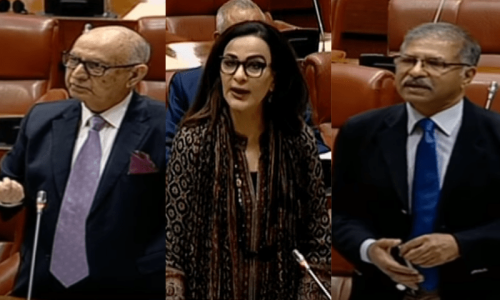THE report Understanding Fata is the outcome of a yearly statistical exercise that documents the perceptions of the region’s people.
For the past five years, it has been effectively conducted by the Community Appraisal and Motivation Programme. This year’s report not only covers new ground but provides the trends prevalent amongst the tribesmen’s perceptions during this period.
In this way it makes available empirical data regarding various shifts in opinion that are taking place and also provides information on how Fata is changing.
According to one school of thought, the Afghan Taliban movement was a product of the chaos resulting from the cessation of the Soviet-Afghan war and the absence of a viable state in that country. The civil war from 1992 to 1996 between the various Afghan Mujahideen factions caused massive destruction to what had survived the Soviet war, including the weakening of the Afghan social structure. This fell apart because of the support provided to religious factions and groups, as opposed to the traditional elders of society. This choice, according to this school of thought, ensured that a new elite would emerge in Afghanistan once the hostilities were over.
That is what happened and a whole new crop of powerbrokers arose that had obtained power, money and weaponry during the Afghan jihad. During this period the Pushtun belt of Afghanistan became home to warlords who, after the US invasion of Afghanistan in October 2001, became a permanent feature of the Afghan terrain. These warlords provided their services to the US military and that began a process of social dominance based upon their support to the US. It was such warlords that the Afghan Taliban had marginalised to create their Islamic Emirate.
Most of the quotas in the Afghan National Army and the police are filled by foot soldiers of these warlords. Therefore, the hope that security will be brought under control after 2014 by these new recruits is based on unfounded optimism. The Afghan military, already suspect, will fragment after the US withdraws.
Inside Pakistan, the public sympathised with the Afghan Taliban as they were seen as an anti-colonial front fighting against the US intervention that many thought was aimed against the Taliban’s rising ambitions towards Central Asia.
Now, however, the situation is different. It is natural that the media affect perceptions and as in the rest of Pakistan, this factor affected the mindset of people in Fata too. The Fata population has realised that the Taliban — whether Afghan or Pakistani — are either terrorists (the opinion held by 30 per cent of those surveyed) or uneducated youth (23 per cent). There has been a major shift in perception here; in 2008, 56 per cent of the population considered the Afghan Taliban to be heroes. In 2011, only 24 per cent believed them so and an equal percentage saw them as a terrorist outfit.
In 2011, similarly, 57 per cent saw Al Qaeda in an unfavourable light. A year earlier, 72 per cent had seen them in an unfavourable light. It would appear that as the threat from this group diminished, people were no longer afraid and gave them greater benefit of doubt.
In terms of suicide bombings, almost 60 per cent said that it had no religious sanction. This finding is supported by cross-comparison where the main causes of suicide bombings were thought to be unemployment (22 per cent), poverty (17 per cent) and intelligence failings (17 per cent).
An examination of the answers to the questions about the media provides some unusual results. Whereas in 2008 only 30 per cent of the respondents relied for news on Radio Pakistan, by 2011 49 per cent relied on it. Of foreign broadcasts, Voice of America proved to be the main source of news for 20 per cent of the respondents while the BBC was relied upon by 10 per cent of the listeners. Similarly, PTV was watched by 28 per cent of respondents. It must be noted that if the coverage of PTV increases, the audience and the government’s influence over this audience will also increase.
Roughly 19 per cent of Fata’s inhabitants have been displaced internally at one time or another during 2011. Asked which places are the most insecure due to violence, the respondents — 59 per cent of which were displaced internally during that year — named Orakzai. A surprising result was that 70 per cent of the people from frontier region Dera Ismail Khan had been displaced internally. This is a very high figure and indicates a takeover of this region by militants. This in itself is not surprising since the region lies between Khyber Pakhtunkhwa and Balochistan, but the number raises questions about who the militants are. This has not been reported in the press and neither does one hear of operations in these parts; what is happening there?
Frontier region Tank is another area that has suffered heavily, with 53 per cent of its inhabitants being internally displaced during the year. By comparison, despite reports of fighting or threats from militants and the Tehrik-i-Taliban Pakistan, 90 per cent of the inhabitants of South Waziristan did not suffer displacement and in North Waziristan, only 12 per cent were displaced.
These are low numbers for disturbed areas.
Thus, the survey’s findings negate the popular impression that North and South Waziristan are suffering the brunt of the internal displacement issue. One could say that these regions have not been affected too much by the war, even though the concentration of forces is quite heavy in South Waziristan and the threat looms over North Waziristan all the time.
The trends thus indicate that militancy in Fata and Khyber Pakhtunkhwa is on the wane. Now is the time for the state to root out violence permanently by improving community policing.
The writer is chairman of the Regional Institute of Policy Research in Peshawar.
azizkhaild@gmail.com











































